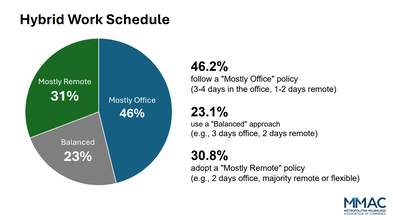
During the 2020 pandemic, employers across the nation were forced to pivot. Meetings in the office boardroom quickly shifted to video calls from kitchen tables and living room couches. Nearly five years later it seems that full-time, in-office work is rare. In fact, data indicates that Milwaukee area organizations have embraced flexible work options and will continue to do so moving forward.
In September, MMAC distributed a survey to chief human resources officers (CHRO) in the chamber’s peer roundtable program. The purpose of the survey was to gauge current and anticipated work modalities at local organizations.
- What is your current corporate staff work schedule policy for each option?
- Full- time remote
- Hybrid (remote/in-office)
- Full-time in-office
- Other (unique arrangements)
- Do you plan to change these work schedule requirements in the future?
- Yes- If yes, briefly describe the unexpected changes.
- No

“At MCW, we’ve embraced a flexible work environment, recognizing that our employees’ talents, energy and commitment transcend physical location. Whether they work on-site, remotely or in a hybrid model, we are fully committed to supporting their productivity and well-being, while maximizing space efficiency and reducing unnecessary infrastructure costs.”
-Adrienne Mitchell, Medical College of Wisconsin
“Our corporate office embraces a hybrid work schedule that prioritizes workplace flexibility, allowing employees whose roles permit remote work to enjoy a better work-life balance while meeting organizational goals. This model requires employees to collaborate with their managers to plan their schedules, ensuring alignment with professional responsibilities. However, employees under performance coaching or disciplinary action are not eligible for this program. We firmly believe that treating employees like adults fosters a sense of responsibility and accountability, ultimately enhancing their performance and commitment to the organization.”
-Aimee Therrian, Centromotion



